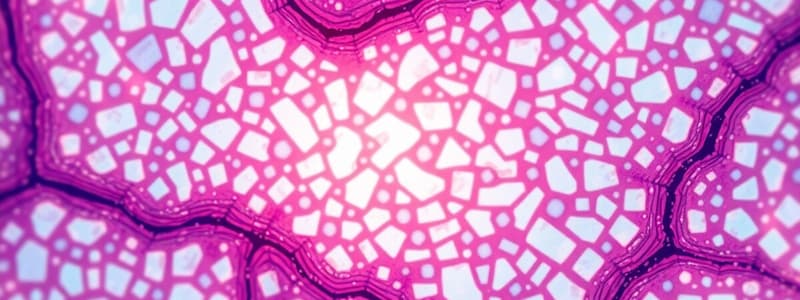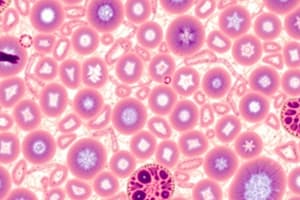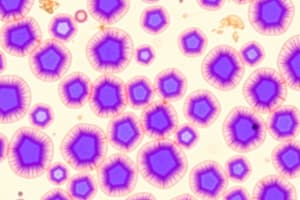Podcast
Questions and Answers
Which characteristic is LEAST descriptive of epithelial tissue?
Which characteristic is LEAST descriptive of epithelial tissue?
- Specialized contacts such as tight junctions and desmosomes.
- Presence of an extracellular matrix that separates cells. (correct)
- Polarity with apical and basal surfaces.
- High regenerative capacity.
A tissue specimen shows a single layer of flattened cells. Which type of epithelium is this MOST likely to be?
A tissue specimen shows a single layer of flattened cells. Which type of epithelium is this MOST likely to be?
- Simple cuboidal epithelium
- Stratified squamous epithelium
- Transitional epithelium
- Simple squamous epithelium (correct)
Which type of gland releases its secretions via exocytosis?
Which type of gland releases its secretions via exocytosis?
- Endocrine gland
- Apocrine gland
- Merocrine gland (correct)
- Holocrine gland
What is the primary role of reticular connective tissue?
What is the primary role of reticular connective tissue?
Which type of cartilage is MOST suited to withstand compressive shock?
Which type of cartilage is MOST suited to withstand compressive shock?
Which feature is unique to cardiac muscle tissue?
Which feature is unique to cardiac muscle tissue?
What is the fundamental function of nervous tissue?
What is the fundamental function of nervous tissue?
Which characteristic is shared by both hyaline cartilage and bone tissue?
Which characteristic is shared by both hyaline cartilage and bone tissue?
Which of the following is a primary function of simple columnar epithelium?
Which of the following is a primary function of simple columnar epithelium?
If a tissue is described as avascular, from where does it receive nutrients?
If a tissue is described as avascular, from where does it receive nutrients?
Flashcards
What is Epithelial Tissue?
What is Epithelial Tissue?
Covers body surfaces, lines cavities/organs, and forms glands for protection, absorption, and secretion.
What is Simple Squamous Epithelium?
What is Simple Squamous Epithelium?
Single layer of flattened cells; enables diffusion and filtration.
What are Endocrine Glands?
What are Endocrine Glands?
Glands secreting hormones directly into the bloodstream.
What is Connective Tissue?
What is Connective Tissue?
Signup and view all the flashcards
What is Areolar Connective Tissue?
What is Areolar Connective Tissue?
Signup and view all the flashcards
What is Dense Regular Connective Tissue?
What is Dense Regular Connective Tissue?
Signup and view all the flashcards
What is Elastic Cartilage?
What is Elastic Cartilage?
Signup and view all the flashcards
What is Muscle Tissue?
What is Muscle Tissue?
Signup and view all the flashcards
What is Skeletal Muscle?
What is Skeletal Muscle?
Signup and view all the flashcards
What is Nervous Tissue?
What is Nervous Tissue?
Signup and view all the flashcards
Study Notes
- Cell tissues are collections of similar cells performing specific functions in the body
- They are organized into four basic types: epithelial, connective, muscle, and nervous tissue
- The study of tissues is called histology
Epithelial Tissue
- Covers body surfaces, lines body cavities and organs, and forms glands
- Functions in protection, absorption, filtration, excretion, secretion, and sensory reception
- Key Characteristics:
- Cellularity: composed of closely packed cells with minimal extracellular matrix
- Special contacts: cells are connected by tight junctions and desmosomes
- Polarity: apical (upper, free) and basal (lower, attached) surfaces
- Support: supported by connective tissue
- Avascularity: lacks blood vessels; nourished by diffusion
- Regeneration: high regenerative capacity
- Classification:
- Based on the number of cell layers: simple (single layer) or stratified (multiple layers)
- Based on cell shape: squamous (flattened), cuboidal (cube-shaped), or columnar (column-like)
- Simple Epithelia:
- Simple squamous epithelium: single layer of flattened cells and allows for diffusion and filtration
- Simple cuboidal epithelium: single layer of cube-shaped cells involved in secretion and absorption
- Simple columnar epithelium: single layer of column-shaped cells involved in absorption and secretion and may have microvilli or cilia
- Pseudostratified columnar epithelium: single layer of cells of varying heights and all cells attach to the basement membrane, but not all reach the apical surface, involved in secretion and propulsion of mucus
- Stratified Epithelia:
- Stratified squamous epithelium: multiple layers of flattened cells and protects against abrasion
- Stratified cuboidal epithelium: typically two layers of cube-shaped cells and found in some sweat and mammary glands
- Stratified columnar epithelium: multiple layers of column-shaped cells and found in the male urethra and some glandular ducts
- Transitional epithelium: able to change shape from cuboidal to squamous and found in the urinary bladder
- Glandular Epithelium:
- Endocrine glands: ductless glands that secrete hormones into the bloodstream
- Exocrine glands: secrete products onto body surfaces or into body cavities via ducts
- Exocrine glands can be unicellular or multicellular
- Modes of secretion: merocrine (secretion by exocytosis), apocrine (accumulation of products at the apical surface which then pinches off), and holocrine (accumulation of products until the cell ruptures)
Connective Tissue
- Supports, connects, and separates different types of tissues and organs in the body
- Characterized by an extracellular matrix composed of ground substance and fibers
- Key Characteristics:
- Extracellular matrix: nonliving material that separates the living cells
- Ground substance: unstructured material that fills the space between cells and contains fibers
- Fibers: collagen, elastic, or reticular fibers
- Common origin: all arise from mesenchyme
- Varying degrees of vascularity
- Types:
- Connective tissue proper: loose and dense connective tissues
- Cartilage: hyaline, elastic, and fibrocartilage
- Bone tissue
- Blood
- Connective Tissue Proper:
- Loose connective tissues:
- Areolar connective tissue: supports and binds other tissues and is universal packing material
- Adipose tissue: stores fat and insulates and cushions organs
- Reticular connective tissue: forms a soft internal skeleton (stroma) that supports other cell types
- Dense connective tissues:
- Dense regular connective tissue: primarily parallel collagen fibers and resists strong tension when applied in one direction; forms tendons and ligaments
- Dense irregular connective tissue: irregularly arranged collagen fibers and withstands tension exerted in many directions; found in the dermis of the skin
- Elastic connective tissue: contains a high proportion of elastic fibers and allows tissue to recoil after stretching
- Loose connective tissues:
- Cartilage:
- Chondrocytes are the main cell type; located in lacunae
- Hyaline cartilage: supports and reinforces; resilient cushioning properties; covers ends of long bones
- Elastic cartilage: maintains the shape of a structure while allowing great flexibility; supports the external ear
- Fibrocartilage: tensile strength allows it to absorb compressive shock; found in intervertebral discs
- Bone Tissue:
- Osteocytes are the main cell type; located in lacunae
- Supports and protects; provides levers for muscles to act on; stores calcium and other minerals
- Blood:
- Red blood cells, white blood cells, and platelets; surrounded by a fluid matrix (plasma)
- Functions in transport of respiratory gases, nutrients, wastes, etc
Muscle Tissue
- Responsible for movement
- Three types: skeletal, cardiac, and smooth
- Key Characteristics:
- Highly vascularized
- Responsible for movement
- Types:
- Skeletal muscle:
- Attached to bones and responsible for voluntary movement
- Cells are long, cylindrical, multinucleate, and striated
- Cardiac muscle:
- Forms the walls of the heart and is responsible for involuntary movement
- Cells are branched, uninucleate, striated, and connected by intercalated discs
- Smooth muscle:
- Found in the walls of hollow organs and responsible for involuntary movement
- Cells are spindle-shaped, uninucleate, and lack striations
- Skeletal muscle:
Nervous Tissue
- Responsible for communication and control in the body
- Consists of neurons and supporting cells called neuroglia
- Key Characteristics:
- Neurons: generate and conduct nerve impulses
- Neuroglia: support, insulate, and protect neurons
- Types:
- Brain
- Spinal cord
- Nerves
Studying That Suits You
Use AI to generate personalized quizzes and flashcards to suit your learning preferences.




